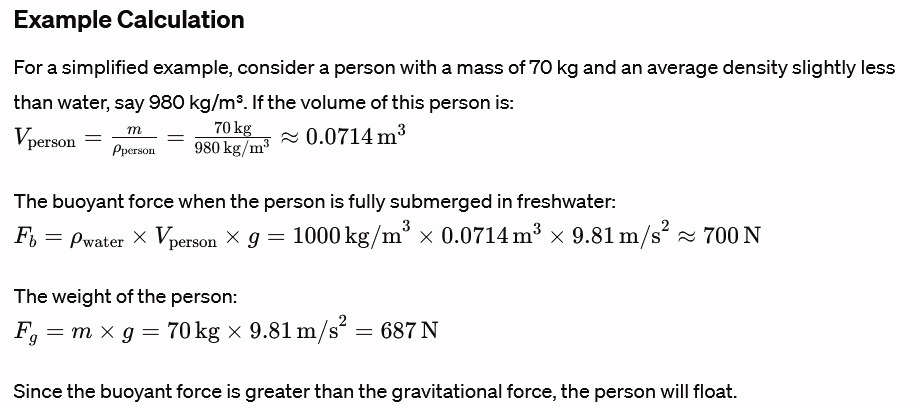1, 2, 3
And, we all float on….
[Instrumental, Electric Piano, Bass]
[Verse 1]
Something’s keeping me a float
Keeping my head above water
In a world so cutthroat
Rise above the slaughter
[Chorus]
A buoyant force
Keeping me on course
Rise above
With the force of love
[Instrumental, Guitar Solo, Drum Fills]
[Verse 2]
Keeping my head above water
So I can see reality
Getting harder as it’s getting hotter
I guess we’ll see
[Chorus]
A buoyant force
Keeping me on course
Rise above
With the force of love
[Instrumental, Guitar Solo, Drum Fills]
[Bridge]
Buoyancy
Sensitivity to density
Replaces
Displaces
As a matter of fact
I’m flat on my back
[Chorus]
A buoyant force
Keeping me on course
Rise above
With the force of love
[Outro]
Buoyancy
Sensitivity to density
[End]
A SCIENCE NOTE
The ability of humans to float on water is primarily governed by the principles of buoyancy and density. Here are the key physics concepts involved:
Buoyancy
Archimedes’ Principle:
- This principle states that any object submerged in a fluid (liquid or gas) experiences an upward buoyant force equal to the weight of the fluid that the object displaces.
- For a human body to float, the buoyant force must equal the gravitational force (weight) acting on the body.
Buoyant Force:
- Buoyant force (F_b) can be calculated using the formula: Fb=ρfluid×Vdisplaced×g where:
- ρfluid is the density of the fluid (water, in this case).
- Vdisplaced is the volume of the fluid displaced by the object.
- g is the acceleration due to gravity.
Density
Density of the Human Body:
- Density (ρ) is mass per unit volume (ρ=mV).
- The average density of the human body is slightly less than that of water, primarily due to the presence of air in the lungs and body cavities, and fat tissues, which are less dense than water.
Comparison with Water:
- Freshwater has a density of approximately 1,000 kg/m³.
- If a human body’s density is less than 1,000 kg/m³, the body will float because the buoyant force will be greater than the gravitational force acting on the body.
Factors Affecting Floating
Lung Capacity:
- Air in the lungs significantly affects buoyancy. Inhaling increases lung volume, reducing the overall density of the body and making it easier to float.
- Exhaling decreases lung volume, increasing the body’s density and making it more likely to sink.
Body Composition:
- Fat tissue is less dense than water, while muscle and bone are denser. People with higher body fat percentages tend to float more easily.
- Muscular individuals with low body fat may find floating more challenging.
Body Position:
- Spreading the body out (e.g., lying flat on the back) increases the surface area and volume of water displaced, enhancing buoyancy.
- Compact positions (e.g., tucking knees to the chest) decrease the volume of displaced water, reducing buoyancy.
Example Calculation
For a simplified example, consider a person with a mass of 70 kg and an average density slightly less than water, say 980 kg/m³. If the volume of this person is: Vperson=mρperson=70 kg980 kg/m3≈0.0714 m3
The buoyant force when the person is fully submerged in freshwater: Fb=ρwater×Vperson×g=1000 kg/m3×0.0714 m3×9.81 m/s2≈700 N
The weight of the person: Fg=m×g=70 kg×9.81 m/s2=687 N
Since the buoyant force is greater than the gravitational force, the person will float.
In summary, humans float on water due to the buoyant force exerted by the displaced water, which, for most people, exceeds their weight due to the lower density of the human body compared to water. Factors such as lung capacity, body composition, and body position significantly influence this buoyancy.
